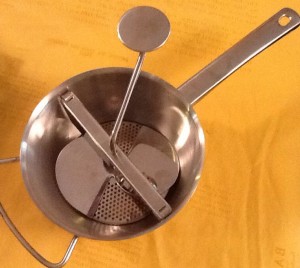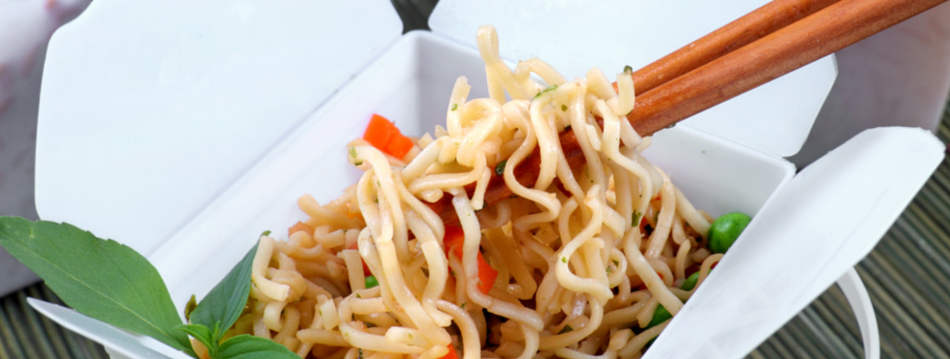
Everyone loves mashed potatoes, but do you like yours smooth or lumpy, smashed or mashed and silky? Chances are good that if you’re my age, your grandmother had a potato ricer, and you remember her mashed potatoes as creamy and silky. When I was growing up (in the 1960s) instant mashed potatoes began appearing, and that became the norm in many households. We were not a mashed potato family. I don’t recall having them, very often, maybe because we weren’t gravy people either. I do think there was always a box of instant mashed potatoes around, and I keep a box of potato flakes in my pantry, but more about those later.
.png)
Before I went to culinary school I made mashed potatoes two ways, either I peeled, cubed, cooked and mashed them, or I used small red or white potatoes (back before the Yukon gold rush) left the skin on, and smashed them leaving a chunky and hearty potato concoction, smashed potatoes. My first encounter with the gigantic potato ricer at school was revelatory. The thing was huge, and could hold over one pound of potatoes, no peeling was needed, and best of all the resulting mashed potatoes were completely smooth and creamy! Oh!
What can you do to make even better mashed potatoes than you’ve been making?
According to Shirley Corriher author of the amazing Cookwise, as you cook the potatoes the starch molecules expand, and then when you start to mash them, if you do that too vigorously, you free way too many starch molecules which causes that gluey mess. One way to avoid this if to twice cook the potatoes, cook them for 20-30 minutes, drain, and rinse under cool water to let the starch gelatinize, and harden. Allow to cool for 20 minutes, then cook again until tender (which should take about ten minutes). This effect is somewhat mitigated when you cook your potatoes skin on, as the skin keeps some of the water out of the starchy interior. If you are going to peel your potatoes before mashing you could use the above mentioned method, and make this adjustment: cook the potatoes skin on for the first part of the process, then cool, and peel, and cook again. This would work well for a dinner (like Thanksgiving) where you want to do as much pre-work as possible.
To speed up the cooling process for hot potatoes make a few slits in the skin to allow the steam to escape. If you’re planning on mashing your potatoes with skin, which is fine for thinner skinned potato varieties, I recommend boiling them whole, then gently mashing with a potato masher (over-mashing will lead you back to glue-ville). I have both a ricer and a food mill, and though you can make great mashed potatoes without them, those will give you the most creamy mashed potatoes! Have you ever tried making mashed potatoes in a food processor? GLUE is what you’ll get, so no matter what, keep your potatoes out of the processor, and the electric mixer.

 Of course the key to really great mashed potatoes is the ratio of butter-salt-cream to potato. I have mentioned this before, but for the famous mashed potatoes at Parc here in Philadelphia they use a food mill, Yukon gold potatoes, and, one pound of butter to two pounds of potatoes, gee, no wonder they’re good! They claim their secret is using Yukon golds, yeah, right. Joel Robuchon is also famed for his mashed potatoes also uses that same 2:1 ratio. You are probably going to want to dial that back, but even using half that amount of butter is probably way more than you’re accustomed to using. As with all things, it’s all about balance, so if you want to have incredible mashed potatoes, have them, just not often, but if you’re going to make them, why not make them as good as they can be?
Of course the key to really great mashed potatoes is the ratio of butter-salt-cream to potato. I have mentioned this before, but for the famous mashed potatoes at Parc here in Philadelphia they use a food mill, Yukon gold potatoes, and, one pound of butter to two pounds of potatoes, gee, no wonder they’re good! They claim their secret is using Yukon golds, yeah, right. Joel Robuchon is also famed for his mashed potatoes also uses that same 2:1 ratio. You are probably going to want to dial that back, but even using half that amount of butter is probably way more than you’re accustomed to using. As with all things, it’s all about balance, so if you want to have incredible mashed potatoes, have them, just not often, but if you’re going to make them, why not make them as good as they can be?
Yukon golds make good mashed potatoes for a few reasons: they have a buttery flavor, they have a pretty color, and they are almost as high in starch as Idaho potatoes which are the classic potato for mashed, and baked potatoes. The Idaho is a great masher because its mealy texture allows it to absorb butter, or sour cream more readily than its more waxy cousins. The mashed potatoes most of us grew up on were Idaho Russets, and the waxy potatoes, like the red bliss, and white rose, were used for potato salad, or the yummy parslied potatoes my mom used to make.
If you haven’t already forgotten, you may be wondering why I, or anyone would keep dehydrated potatoes on hand, but I consider them one of my secret culinary weapons in the war against errors. Please note, though these are called instant mashed potatoes, the single ingredient is potatoes. Last week I was working on some mashed potatoes for this post, and added too much cream. By adding a tablespoon of my instant mashed I was able to salvage the potatoes! They also make a great thickener for pea and bean soups, though I don’t recommend them for gravy, as they add texture.
There are many things you can do to enhance mashed potatoes. Substitute sour cream for heavy cream, add any grated cheese from Parmesan to cheddar, or stir in some creamy goat cheese. One of my favorite winter-time treats is to throw some cauliflower and carrots in with the potatoes, and mash them up. You can substitute olive oil for the butter, but use much less. Fresh herbs or chives will add color and flavor. And finally, another treat is taking any leftovers making them into patties, and dipping them in egg wash, then breadcrumbs and frying them, though you probably won’t have much leftover.
What is your favorite way to make mashed potatoes? What do you like to add in?
Simple Mashed Potatoes
| Serves | 2-4 |
| Cook time | 30 minutes |
Ingredients
- 1lb potatoes (Yukon gold, or Russet)
- 4 tablespoons unsalted butter (cold and cut into 4 pieces)
- 1/2 cup heavy cream (warmed, but not to boiling)
Directions
| Step 1 | |
 Put potatoes in a pot with enough cold water to cover, add 2 TBL of salt, and cover Bring to a boil, then lower heat to medium | |
| Step 2 | |
 Cook potatoes for 30 minutes, and test for doneness, a knife should slip easily in and out of the potato, if the is resistance cook another 5 minutes and test again. Bigger potatoes will take longer | |
| Step 3 | |
 When potatoes are cooked,drain and return potatoes to pot to dry If you are going to peel potatoes, slash the skin in a few places to let potato cool enough to handle If you're going to use a food mill or ricer, there is no need to peel potatoes, the device will do that | |
| Step 4 | |
 Warm cream on stove or in microwave Prepare potatoes and put into a bowl, add butter, and gently fold in, then add cream, and mix gently Season to taste | |




.jpg)





Peggy Gilbey - Hi Nancy, my favorite way to cook mashed potatoes is to boil them until fully cooked, drain, then return them to the pot on medium high heat, stirring gently just until the outer moisture is removed. This takes just a couple of minutes. I then proceed with mashing and added additions from there. Folks love my mashed potatoes and they are a favorite comfort food to me. On instant mashed potatoes, my siblings and I used to be so Jealous when other kids families had instant mashed potatoes- only fresh in our home, and today, well, only still. Interesting Post, thank you.
nrlowell@comcast.net - Peggy, it sounds like your method is very much like Corriher’s, and they sound great. I know what you mean about being jealous of things other kids ate, we grew up on what is now called real food. I was jealous of the fun things other kids got like fish sticks, and TV dinners.
Linda LindySez Baker - Yes, I use the ricer when I want them smooth and silky – with Idaho russets, or the potato masher, when I want them chunky…
nrlowell@comcast.net - Linda, I do the same. Sometimes you just want a chunky mashed potato!
Karen Rodwill Solomon - I ALWAYS use Yukon Gold with cream, butter, salt and a dash of garlic. Sometimes cheese, I love cheese….
nrlowell@comcast.net - Yes,
I love Yukon golds for mashed potatoes, especially if I’m mashing not ricing them.
don - Always looking for ways to improve mashed potatoes! It’s my mom’s favorite dish.
I was turned on to a way to cook fingerling potatoes (talking potatoes now) that basically involved boiling them whole in like half a pound of salt. Every heard of such a thing? They were really good though.
nrlowell@comcast.net - Don, I have heard of this. Years ago I had a friend who made what he called salt potatoes, made just the way you describe, but with small new white potatoes. It is amazing the variety of potatoes we have available now, compared to what there was back in the 1980s.
Paulina Piskorz - Hey Nancy, when I make mashed potatoes, I always boil them with a pinch of baking powder because they become very fluffy thanks to this 🙂 You can read the whole tip here: http://www.listonic.com/protips/get/xvmmvliuzu
nrlowell@comcast.net - Paulina, I haven’t tried that, but I will, I still have a lot of potatoes on hand!